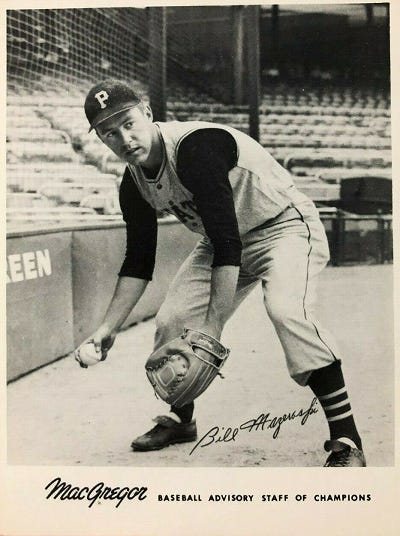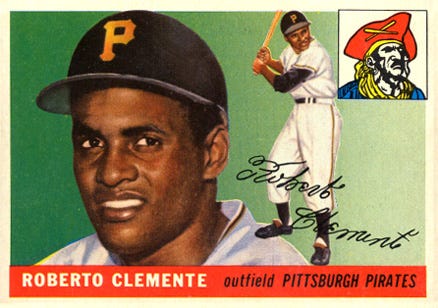Don Hoak Turned Himself About in Pittsburgh
He did it in a hurry, too -- nothing pokey about it!
1960 Topps Don Hoak (#373) - Card of the Day
The 1960 Pittsburgh Pirates were loaded with stars, future legends, and men who accomplished some amazing feats in their careers. The three categories were not mutually exclusive, but it’s easy to forget any one player (except one or two maybe) and get lost in the jumble of significant events surrounding this crew.
Consider just a few of the stories:
Roberto Clemente was an All-Star for the first time in 1960 and went on to become one of the most revered figures in the game’s history.
Bill Mazeroski lived out every little boy’s dream by hitting the World Series-winning home run in the bottom of the ninth inning in Game 7 of 1960 Fall Classic…over the New York Yankees, no less.
Roy Face put up an amazing 18-1 record as a reliever in 1959.
That same year (1950), Harvey Haddix pitched 12 perfect innings against the Milwaukee Braves before losing the game in the 13th.
Vern Law won the 1960 Cy Young award by going 20-9 with 18 complete games…and rotation-mate Bob Friend may have been even better.
Shortstop Dick Groat led the majors in batting average (.325) and won the National League MVP award in 1960.
The list could go on, but these are probably the most visible and memorable among the group of individual accomplishments, though manager Danny Murtaugh wasn’t done making an impact on the Pirates and on the 1960 team in particular.
More on that in a bit, but first, can you see how some pretty nifty but maybe less-glitzy performances might get lost in the glare of the busy schedule these frontliners maintained with history?
For example, if we accept that Groat was the best player on Pirates that long-ago summer (by virtue of hardware and WAR, at least), then who was his runner-up? Friend and Law have some claim to the title, and first baseman Dick Stuart led the team with 23 home runs, but Dr. Strangeglove was up to his usual tricks in the field.
And Clemente was not yet CLEMENTE.
So who does that leave? Well, Smoky Burgess, Maz, and Bob Skinner were All-Stars that summer, as were Friend, Law, and Face. And Bill Virdon put up maybe his best overall season since winning Rookie of the Year honors in 1955.
There were some pretty stellar non-regulars who made big contributions to the ‘60 club, too — Hal Smith, Rocky Nelson, Dick Schofield. All excellent players, and all vital to Pittsburgh’s title in one way or another.
But the guy who topped all others except Groat, by measure of both WAR and MVP voting, was third baseman Don Hoak. And, like Haddix and Burgess, Hoak could just as easily have been a part of the 1961 Reds team that dethroned the Pirates as National League champions.
Here’s how it happened…
Originally signed by the Brooklyn Dodgers before the 1947 season, Hoak didn’t make his big league debut until seven years later, in April of 1954. He’d spend parts of the next two seasons with the Bums before they traded him, Russ Meyer, and Walt Moryn to the Cubs for Don Elston and Randy Jackson in December 1955.
By then, Hoak had shown some power and that he could hold down third base, but at age 27, his prospect days were behind him. Things didn’t go so well in Chicago in 1956, either, as his batting average slid to .215, and his power deflated, too (.311 slugging percentage).
So that November, Hoak was on the move again, shipped to the Reds (or Redlegs, thanks to the Cold War) with Warren Hacker and Pete Whisenant in exchange for Ray Jablonski and Elmer Singleton. There in Cincy, Hoak’s fortunes took a turn for the better as he hit .293 with 19 home runs and 89 RBI over 149 games.
The next summer, he managed to play in just 114 games and his offensive numbers slid across the board at age 30. That made him expendable enough for the Reds to trade him, Haddix, and Burgess to Pittsburgh for Whammy Douglas, Jim Pendleton, John Powers, and slugger Frank Thomas in January of 1959.
Thomas put up one fairly miserable season for the Reds, splitting time at third with Willie Jones before heading off to the Cubs in 1960. The other three new guys contributed little (Pendleton and Powers) or nothing (Douglas) to the 1959 Reds.
Meanwhile, Hoak, Haddix, and Burgess all settled in to big roles for the Pirates right away. And they all contributed to history almost right away, too, with Burgess catching Haddix’s near-perfecto and Hoak committing the 13th-inning error off the bat of Felix Mantilla that spoiled spotlessness.
Overall, though, Hoak found Pittsburgh to his liking in 1959. Not only did he lead the National League with 155 games played, he also hit .294 with eight home runs and 65 RBI. He even stole a career-high nine bases against just two times being thrown out.
And that’s where we find Hoak on his 1960 Topps baseball card, a baseball late bloomer with a new lease on diamond life after a rebound/breakout in a new city. And things would only get better in 1960.
Playing in 155 games again, Hoak hit .282 with 16 home runs and 79 RBI to go along with 97 runs scored and nine triples. It all amounted to a career-high 5.4 WAR. And before you go all “WAR-is-more-made-up-than-Bigfoot” on me, let me direct you to the MVP voters of the day, who slotted Hoak as the second-most valuable player in the N.L., right behind Groat.
Things were never quite that great for Hoak again, or for the Pirates while he was with them, but he did turn in a star-level performance in 1961 before sliding in 1962. The Bucs traded him to the Phillies for Pancho Herrera and Ted Savage that November, and Hoak notched one full season in Philadelphia before finishing with a six-game stint to begin 1964.
Hoak wasn’t quite done with baseball, though, and embarked on a coaching and managerial career that led him to Pittsburgh’s doorstep again in 1969 after the Pirates fired skipper Larry Shepard as the season wound down.
Hoak lobbied for the job, but the Bucs went with Murtaugh, who had stepped away in 1967 for medical reasons. Later the day he found out his short-term baseball fate, Hoak witnessed a thief nab his brother-in-law’s wheels, gave chase, and suffered a heart attack while in pursuit.
Hoak made it to the hospital but died soon after at age 41. Today would have been his 97th birthday.
Maz in His Element
Mazeroski made it to the Hall of Fame largely on the strength of his Gold Glove leather at second base…and that shining October moment, of course. Before his most famous flash of the lumber, collectors in 1960 could get a black-and-white glimpse of Maz in his element, courtesy of his MacGregor Sporting Goods baseball card. Read about that issue right here.
The (Original) Great One(s)
Wayne Gretzky became known as “The Great One” for his revolutionary play on the ice, but Clemente owned the nickname first…and it still fits. No surprise that his Clemente’s cards have been and remain among the most popular in the hobby. Read about some of his “great ones” right here.






